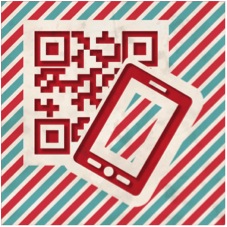Factoid: the QR code (short for Quick Response Code) was first designed for the automotive industry in Japan. Introduced in 1994—long before we had smartphones to scan them with—the code’s purpose was to track a vehicle’s progress through the manufacture process.

Today, QR codes can be found everywhere from magazines to corner benches, directing consumers to sites ranging from real estate to women’s fragrance and everywhere in between. They may be standard black and white, or colorfully graded to include a company’s logo. They can even be gigantic and composed of people holding umbrellas: the current record-holding world’s largest QR code encompassed 27,000 square feet, composed of 2,503 employees of the Coca-Cola company in n Zhengzhou City, China standing in formation, holding raised red and white umbrellas.
As useful-yet-novel as QR codes may be, when using them for your business, or when scanning codes in your personal dealings, there are several functionality and security issues that must considered. Security concerns regarding QR codes fall into one of multiple camps: where the code was generated, how the code is scanned, and the code’s destination.
Code Generation
QR codes can convey an enormous amount of information: while a standard barcode can represent up to 20 characters of information, QR codes can carry thousands of characters. There are hundreds of free code generators online, making it easy for hackers, and others with malicious intent to create a code, post it, and wreak havoc on all those who dare scan it.
When using a code generator, ensure you’re working with a stable, reputable company, and consider the lifespan of the material on which the code will appear. Codes may be considered proprietary by the company whose software you’ll use to generate it, so if the company closes or is acquired, the code may point to a 404 error message page. In addition, if QR codes go out of favor, a brochure meant to be relevant for several years suddenly becomes outdated.
Uncertain Links:
When scanning a code, how can you be certain where it leads? Simply because it’s implied by the information surrounding it? QR codes may convey direct or indirect links, which can be either safe of malicious, and you’ll never know until you scan (without a preview option, that is). Because a QR code’s information is unintelligible to the human eye, users have little indication of where the code may lead, and malicious QR codes may install malware on devices, or direct the user’s device to a questionable website.
Scanning Apps
QR code reader apps used to scan the codes carry their own set of issues, and there are currently no standardization requirements for these apps. Look for readers that allow you to preview the link before visiting the site. Apps include QR & Barcode Reader and Norton Snap both have this functionality.
When incorporating a QR code into your business materials, it’s imperative—for both your own safety, and that of your potential customer—to take security into consideration. Choose a reputable company to develop a QR code strategy: in addition to the aforementioned considerations, look for a company that offers a pricing plan, has a good grasp of the safety concerns involved, and appropriately accommodates error correction. With a bit of knowledge and the right tools, QR codes can work for you, your business, and your customers.